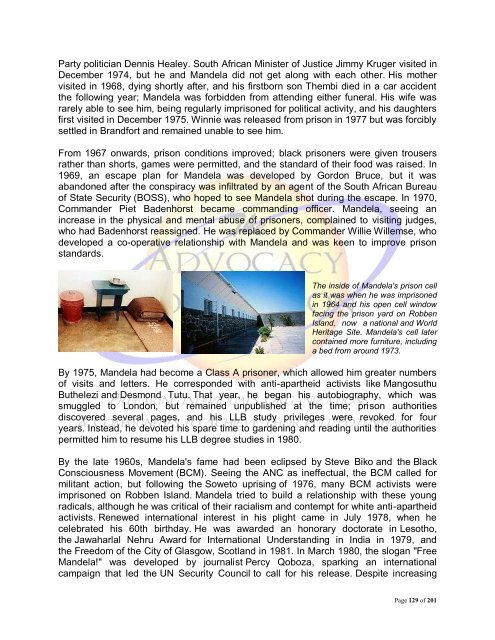You also want an ePaper? Increase the reach of your titles
YUMPU automatically turns print PDFs into web optimized ePapers that Google loves.
Party politician Dennis Healey. South African Minister <strong>of</strong> Justice Jimmy Kruger visited in<br />
December 1974, but he and Mandela did not get along with each other. His mother<br />
visited in 1968, dying shortly after, and his firstborn son <strong>The</strong>mbi died in a car accident<br />
the following year; Mandela was forbidden from attending either funeral. His wife was<br />
rarely able to see him, being regularly imprisoned for political activity, and his daughters<br />
first visited in December 1975. Winnie was released from prison in 1977 but was forcibly<br />
settled in Brandfort and remained unable to see him.<br />
From 1967 onwards, prison conditions improved; black prisoners were given trousers<br />
rather than shorts, games were permitted, and the standard <strong>of</strong> their food was raised. In<br />
1969, an escape plan for Mandela was developed by Gordon Bruce, but it was<br />
abandoned after the conspiracy was infiltrated by an agent <strong>of</strong> the South African Bureau<br />
<strong>of</strong> State Security (BOSS), who hoped to see Mandela shot during the escape. In 1970,<br />
Commander Piet Badenhorst became commanding <strong>of</strong>ficer. Mandela, seeing an<br />
increase in the physical and mental abuse <strong>of</strong> prisoners, complained to visiting judges,<br />
who had Badenhorst reassigned. He was replaced by Commander Willie Willemse, who<br />
developed a co-operative relationship with Mandela and was keen to improve prison<br />
standards.<br />
<strong>The</strong> inside <strong>of</strong> Mandela's prison cell<br />
as it was when he was imprisoned<br />
in 1964 and his open cell window<br />
facing the prison yard on Robben<br />
Island, now a national and World<br />
Heritage Site. Mandela's cell later<br />
contained more furniture, including<br />
a bed from around 1973.<br />
By 1975, Mandela had become a Class A prisoner, which allowed him greater numbers<br />
<strong>of</strong> visits and letters. He corresponded with anti-apartheid activists like Mangosuthu<br />
Buthelezi and Desmond Tutu. That year, he began his autobiography, which was<br />
smuggled to London, but remained unpublished at the time; prison authorities<br />
discovered several pages, and his LLB study privileges were revoked for four<br />
years. Instead, he devoted his spare time to gardening and reading until the authorities<br />
permitted him to resume his LLB degree studies in 1980.<br />
By the late 1960s, Mandela's fame had been eclipsed by Steve Biko and the Black<br />
Consciousness Movement (BCM). Seeing the ANC as ineffectual, the BCM called for<br />
militant action, but following the Soweto uprising <strong>of</strong> 1976, many BCM activists were<br />
imprisoned on Robben Island. Mandela tried to build a relationship with these young<br />
radicals, although he was critical <strong>of</strong> their racialism and contempt for white anti-apartheid<br />
activists. Renewed international interest in his plight came in July 1978, when he<br />
celebrated his 60th birthday. He was awarded an honorary doctorate in Lesotho,<br />
the Jawaharlal Nehru Award for International Understanding in India in 1979, and<br />
the Freedom <strong>of</strong> the City <strong>of</strong> Glasgow, Scotland in 1981. In March 1980, the slogan "Free<br />
Mandela!" was developed by journalist Percy Qoboza, sparking an international<br />
campaign that led the UN Security Council to call for his release. Despite increasing<br />
Page 129 <strong>of</strong> 201

















